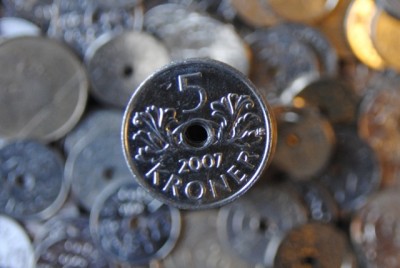The value of Norway’s currency, the krone, took another dive on Thursday after the country’s central bank cut its key lending rate again by a quarter-point – and hinted at a future cut as well. The cut breaks another record for low interest rates, with the bank board hoping it will stimulate the economy.

“Growth prospects for the Norwegian economy have weakened, and inflation is projected to abate further out,” the governor of Norges Bank, Øystein Olsen, said in a prepared statement. “The board has therefore decided to lower the key policy rate now.”
The move brings that key lending rate down to just 0.75 percent, from the already-record-low level of 1 percent set in June. The quarter-point cut immediately resulted in a further weakening of the Norwegian krone, which had been trading at below NOK 8.2 to the US dollar earlier this week. Within minutes of the announcement of the interest rate cut, it suddenly cost NOK 8.45 to buy one US dollar.
The krone also weakened against the British pound, which cost NOK 12.91 compared to 12.73 as late as Tuesday, and the euro, which cost NOK 9.47 by mid-morning Thursday, up from NOK 9.24 on Tuesday.
Growth ‘likely to remain low’
Olsen and the other members of Norges Bank’s Executive Board believe that growth in the Norwegian economy is “likely to remain low for a longer period than projected earlier,” because of the fall in oil prices. Investments in the oil industry are therefore “expected to fall to a further extent than projected in June,” when the board last met and also opted to cut its key lending rate, from 1.25 percent to 1 percent.
Analysts and economists were mixed on whether the central bank should lower rates, with many arguing earlier this week that the bank board should refrain from another cut now. Professor Hilde C Bjørnland at the Norwegian Business School BI cautioned in newspaper Dagens Næringsliv (DN) on Wednesday that another rate cut would only “fire up” the housing market even more at a time when prices already are extremely high. She also warned that household debt levels already are at a “threateningly high level,” which can lead to “great challenges” for an economy facing a transition away from oil. “Interest rates should be held steady,” she advised.
Benefits of a weaker krone
The bank board, however, stated that the decline in oil investment “will reduce activity in other parts of the economy.” The weaker krone, on the other hand, “will contribute to strengthening the profitability of export and import-competing firms.” Several industries, not least tourism and the hotel business, are benefiting from the weak krone that takes some of the sting out of Norway’s notoriously high prices, and makes Norwegian goods and services more competitive.
For the bank board’s own assessment of its monetary policy, click here (external link).
Not only did Olsen announce the rate cut on Thursday, he also stated that “the current outlook for the Norwegian economy suggests that the key policy rate may be reduced further in the coming year.” That clearly contributed to the quick depreciation of the krone, and more debt relief for borrowers.
newsinenglish.no/Nina Berglund

